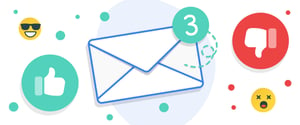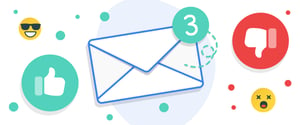How to Write Better Cold Emails When You’re Prospecting
Email campaigns are an inherent part of B2B prospecting. They facilitate the first contact of your sales development team and provide introductory information about your offer. However, writing an effective email is a real challenge, especially since most decision makers have their inboxes full every single day.
Over the past three months, CIENCE has conducted 304 prospecting campaigns for our clients and 12 for our use. For this purpose, our marvelous copywriter Jaslyn Oberoi wrote 1,302 highly-efficient email templates. And we are very proud to have such hard-working professional on our team.
Jaslyn drafts 20 templates per day. And she kindly agreed to share her expertise on how to write killer emails that will persuade your prospects and encourage them to take action.
How Far Have Cold Emails Come?
When cold emails were first written a decade ago, they often didn’t even contain the name of a prospect. We’ve come a long way since then, but we see many of the same mistakes continued to be made in prospecting campaigns today. The biggest one being cold emails can be incredibly self-focused.
The readability of such emails is low and over time, we’ve understood the importance of prospect focused emails.
B2B companies have several buyer personas and create lists of contacts based on them. We call it segmentation. Second, modern CRM software enables a sales team to apply laser targeting in their prospecting campaigns. That’s why we divide the pool of leads into groups based on our buyer personas and make unique offers to each of them.
For example, if your company makes brewery equipment, you will want to have at least three different campaigns. One will target large beer corporations. One will focus on pubs that craft their beverages. And finally, one will aim private brewers.
Therefore, the segmentation and targeting require personalization. And that’s the guiding principle in B2B prospecting campaign.
.jpg?width=688&name=1%20(9).jpg)
Remember your goals
Every prospecting campaign must result in a conversion. Your initial goal is to outreach as many names on your contact list as possible and start a conversation. Ultimately, your sales development team needs to pass qualified leads to your account managers or set appointments.
Your prospecting campaign should be in line with your goals. That’s why you need to write an email that will attract the attention of your leads with a call to action. Below we’ll be discussing how to achieve that most efficiently.
Preparation for a prospecting email campaign
The preparation stage is crucial if you want to create compelling emails. Before even starting to write, you need to know whom you are addressing so you can personalize your email. Personalized emails make the prospect feel like you understand them and know more than just their name. It shows that you’ve spent time to understand their company and who they are. The more personalized your campaign, the more effectively you can communicate with your prospect.
First, Jaslyn thoroughly researches our clients to understand their business, goals and KPI’s. Then, Jaslyn studies the client’s business persona and the pain points that can be solved by the respective product or service. She says it’s imperative to communicate the benefits of the product/service and not just ramble about the features. The prospect needs to clearly understand why their life would become more simple and what problem the product or service would solve.
Pro tips from Jaslyn Oberoi
We had a short interview with Jaslyn asking for her professional suggestions and secrets of successful emails.
How should I address a prospect in my letter?
Conversational and friendly. The more formal, the less the prospect feels like they can relate to you. When you write to them as a friend, they don’t feel like they’re being sold. You want the prospect to feel comfortable and trust you to solve their problems.
How do you personalize an email?
At CIENCE, we use a magical personalization engine that we created to take essential data from different buckets, which our research team will find. It’s significant for the prospect to understand that you know more than just their name, company and job title.
Great ways to connect with prospects is by bringing up an interesting article they wrote, congratulating them on something their company recently achieved or bringing up something you have in common. You can also use gamification in regards to something they’re interested in. The more creative you can get- the better.
.jpg?width=688&name=2%20(7).jpg)
How do I write a subject for an email that secures high open rate?
A subject line is SUPER valuable and sets the tone for your entire email. Ideally, you want 5 words or under. Prospects often open up their emails on mobile so they should be able to see the whole subject line. Your subject should somehow reflect what they will find in your email. Otherwise, you can be penalized by Google.
However, the best subject lines are either personalized, ask questions or are “different.” They should invoke curiosity and make the prospect want to open your email. Another great tactic is making your subject line reflect an email you may internally receive so it looks important to the prospect. Just make sure it’s honest and genuine so you don’t get sent to spam.
It’s always better to think out of the box and go a little weird with the subject line because it’s more interesting than a boring, bland one. We also have success with all lowercase subject lines because that’s how most people email friends and family.
.jpg?width=688&name=3%20(7).jpg)
What’s the best way to sign a letter?
We usually sign emails in a few ways. However, we do not get too formal. “Best,” “Regards” and “Cheers” work pretty well. In addition to that, we sometimes write “Thanks in Advance” or “Thanks.” It’s good always to show the prospect you’re thankful for their time.
Side Note: In a signature for some of our clients, we use the link to a landing page. Our IT team develops it for the purposes of the campaign. The page focuses entirely on a product or service we promote. For more information about this option and why it’s more efficient read here.
What’re the differences between emails in waves?
In the first email, we don’t want to be too aggressive. It should explain what we want the prospect to do and describe who we are. The next few should each ideally focus on ONE benefit. When you provide too much information, people take away nothing.
The last email works best as a breakup email. This type of email is designed to get a response from a prospect from whom you haven’t heard in some time. It helps you understand if the prospects have been busy, aren’t interested or if there’s a better time to reach out to them.
When you act like you’re moving on, it encourages the prospect to be quicker and work more urgently. It’s important though to continue to be kind and conversational when doing this. Being rude to your leads will never work. And if it does, it will hurt your reputation in the long term.
The breakup email should add value before you walk away. Often a useful piece of content works very well. When you give them resources they can use, prospects become more interested.
Side Note: We usually send several emails to one lead within a particular campaign. If a prospect doesn’t open the first email, he’ll receive the next one in 2-3 days and then another one. We call these sequences “waves.” As soon as a letter is opened, a software removes the lead’s address from the send-out of the next emails. There are 3-5 waves.
Read more about waves and cadences here.
Does industry impact the way I should write prospecting emails?
Yes! When writing to a marketing agency you want to talk to them about what matters to them. ROI, marketing investment, ROAS is all important. When you’re writing to a hotel, something like getting direct bookings may be more of value to them. This is where understanding your prospect really matters.
Without knowing what’s critical to the executives in each industry, you won’t know how to speak to them. We wouldn’t say the same thing to a PPC client and a Genomics client because the two industries are very different.
At the same time, it’s important not to use jargon or too many words that add “fluff” or act as “fillers.” We want everything in our emails to add real value to the prospect because your prospects are smart and can see past that.
No matter what the industry is, however, one thing remains the same. And that is how important it is to communicate what problem the product or service will solve for your prospect and why they should care.
Content tips:
- Six sentences or less per email so it’s short and sweet.
- Make sure to use social proof in each email.
- Use the word YOU not “Me, Me, Me”.
- Don’t brag
- Make the call to action easy to understand.
- Ask the prospect for one thing only per email.
- Only talk about one benefit per email.
Jaslyn’s working day
I write about 20 emails per day. First, I get in and look at assignments for the day. I check which ones are a priority. If they’re an existing client, I connect with the Client Success Manager and provide some ideas and strategies for the template. I ask for some data on their existing templates so we can optimize them.
If they’re a new client I go through their questionnaire and learn about them. Then I begin drafting. I typically work on landing pages and emails on any given week but am also jumping on strategy calls and often helping with content related tasks. For example, today I’m working on modifying content some of our clients want to send out. I need to make it easier to read, less feature heavy and more benefit heavy.
***
Summing up, you need to be creative and personalize your emails. Your message should focus on your lead, their pain problems and the way to solve them. Keep it short and readable. Deliver value. And don’t forget about A/B testing! We hope these email tips bring your campaigns better responses and help close more deals.
Did you find this post useful? Read our Fullest Guide to Cold Email Campaigns and learn everything you should know about cold emails.
A Few (Related) Sales Posts
 Read full post: Outbound Emailing in Times of Uncertainty – The Best and Worst of April 2020
Read full post: Outbound Emailing in Times of Uncertainty – The Best and Worst of April 2020
Outbound Emailing in Times of Uncertainty – The Best and Worst of April 2020
 Read full post: 10 Ways to Avoid Emails Going to Spam
Read full post: 10 Ways to Avoid Emails Going to Spam
10 Ways to Avoid Emails Going to Spam
 Read full post: The Good, Bad and Ugly Cold Emails of December
Read full post: The Good, Bad and Ugly Cold Emails of December
